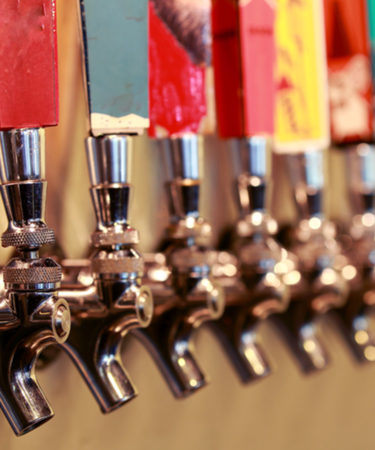As the American craft beer industry evolves, small-town brewpubs are increasingly outnumbered by slick operations poised for multi-city expansions, massive productions, and, of course, rapidly proliferating corporate buyouts.
Taprooms remain essential for all breweries, regardless of size and business model. They provide a physical manifestation of brewery identity, without the carefully worded marketing materials. Does this operation care about what visitors think of its beers, or is it focused on looking good on Instagram? Does it value its community, or its Untapped rating? Visit a taproom, and answers to these questions are immediately apparent.
With that in mind, we asked 11 brewers to tell us what makes for a truly great taproom. Here are their replies.
Don't Miss A Drop
Get the latest in beer, wine, and cocktail culture sent straight to your inbox.“I love going into a taproom and just being able to tell that they are a part of their community and deeply invested. Breweries succeed based on our community’s support, so it is always really nice to see when it’s clearly a mutual partnership. This can be through outreach to other bars and restaurants, supporting community events, raising lots of money for local groups in need, and a million other ways.” — Grant Pauly, Brewmaster, 3 Sheeps Brewing Co.
“The most important aspect of a taproom is the that the tap list be new, interesting, and varied, and the staff knowledgeable about each beer. From a visual ambiance standpoint, thought needs to be put in surrounding what fits your style: TVs to watch sports, cool art, or even old beer paraphernalia. Create a space where people can experience your brewery in some way, taking them beyond just the taproom.” — Ben Edmunds, Brewmaster, Breakside Brewery
“People make a great tap room. And the customers, the bartenders, the music, the beer… all come into play too.” — Andrew Burman, Co-Founder, Other Half Brewing
“It always comes down to the people. There is a stark, bright dividing line between taprooms with engaged and enthusiastic employees and those without. Do the folks across the bar greet with a genuine smile and have an authentic desire to create a memorable experience by introducing me to what is special about their brewery’s craft? What about the back-of-house folks? Do they take available time to interact with guests and bring their technical knowledge to bear on the conversation? When those elements fall into alignment, all for the benefit of the guest, that’s when I know I’m in a killer taproom.” — Jake Goodman, Director of Sales and Marketing, WeldWerks Brewing Co.
“Hospitality first. What makes a killer taproom is they are able to serve a wide variety of guests.” — Joe Connolly, General Manager, Springdale by Jack’s Abby Brewing
“You know you have a killer taproom when you find that you aren’t just selling well-crafted suds, but rather you’re building a community and culture. Our tucked- away suburb is only home to just over 6,000 people, which isn’t a lot to support our taproom. We haven’t been at the top of every internet search or magazine covering the latest trends in beer. We aren’t pouring our beers at a busy intersection, either. Yet somehow people from all over this great land find us… In the end that’s what we think makes ours a killer taproom; being here together.” — Grant Hamilton, Owner and Brewer, Imperial Oak Brewing
“The best taprooms aren’t the vast, cavernous warehouses half-filled with shiny tanks, bearded bros, and cool girls. The smaller, corner taproom that’s bringing back the American dive bar culture is gaining more (sustainable) traction. I don’t want to stand in line for a pint and be sent to wander off on my own, I want to belly up to the bar and have a conversation with a whip-smart bartender who has close relationships with both the beer and their guests alike.” — Kelsey Reidle, Director of Operations, Satulah Mountain Brewing Co.
“A good taproom can have one to 100 different beers, LED screens, all of the bells and whistles, you name it. But a great taproom is all about the people, both in front of and behind the bar.” — Billy Smith, Head Brewer, Kona Brewing Company
“When you are greeted upon walking in the door or when placing your order… When you find that the guests are from all walks of life. When they have amazing craft beer. When they offer consistent quality… When you want to stay for more than a single beer.” — Lia Garcia, Tasting Room Manager, Societe Brewing Company
“You’ll know when you’ve found a killer taproom because you find yourself drawn back again and again. And who can blame you?” – Matt Cox, Brewmaster, Copperpoint Brewing Company
“What brewery tap rooms often forget is that the only true way to show the camaraderie of the independent craft industry is to put someone else’s beer on tap next to yours. It also demonstrates confidence in your product. Second, any great taproom needs a soul… A great taproom should demonstrate the culture complementary to your brand. Finally, a great taproom needs a beer cellar where vintage beers can live. It’s part of every great beer bar and tap room in Belgium, and it creates mystery and intrigue. The key is to limit the physical access to only the true enthusiasts, friends, and loved ones. This gives you a place to truly show your love of craft beer to others; and it’s just badass.” — Colby Cox, Co-founder and Brewmaster, Roadhouse Brewing Co.
